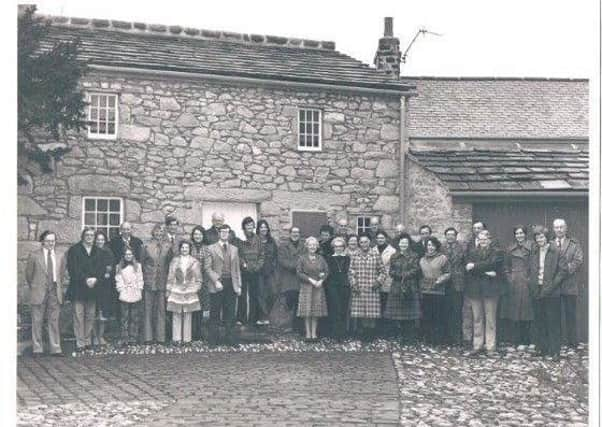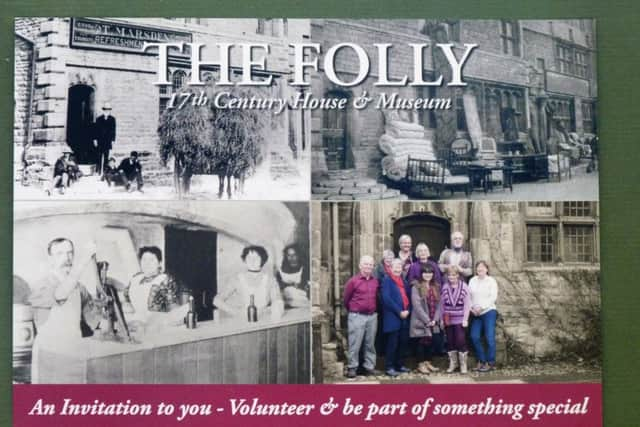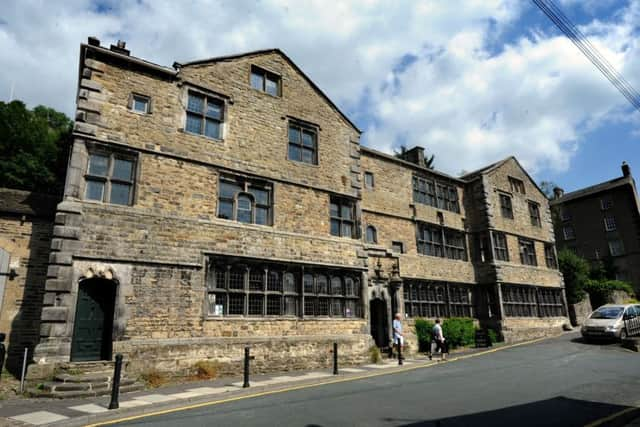Lancaster nostalgia: Help preserve future of Settle Museum


The nine people standing on the steps of the Folly Museum’s postcard are representing the hundreds of volunteers who in 40 years created a fascinating museum out of nothing.
They are smiling because they are proud, because they enjoy what they do, and because they would love you to join them - this is their story.
Advertisement
Hide AdAdvertisement
Hide AdOn New Year’s Day 1977 a group of determined people with a vision gathered in Twisleton’s Yard in the heart of Upper Settle to launch an appeal.


They longed to tell the stories of the buildings around them: a barn, a tinsmith’s workshop, Poorhouse Yard across the road, a tannery, and the walls on the limestone fells above.
They would reveal how people made their living here in this “place of rock crags,” Craig Ven or Craven. They were convinced that by opening everyone’s eyes to the natural and human landscape in Settle and North Craven they could ensure a safer future for the heritage of this unique corner of Yorkshire.
They had resolved to create a museum - certainly a bold ambition with no pot of money and no significant collection of artefacts - but they were prepared to give as much of their time and talents as needed to achieve their dream.
Advertisement
Hide AdAdvertisement
Hide AdThe previous autumn Settle and District Civic Society had formed a Museum Sub-Committee.


They were able to make use of a barn in Twisleton’s Yard for six months to mount an exhibition on the railway shanty towns of Ribblehead; a thousand people came to see it.
The society’s Building Preservation Trust had recently acquired a suitable permanent building. And 1977 was the year of the Queen’s Silver jubilee and communities were looking for commemorative projects.
The Jubilee Museum Appeal brought in essential money, plus a wealth of items for display from farms and kitchens, cobblers, joineries and doctors.
Advertisement
Hide AdAdvertisement
Hide AdEntire valuable collections such as Rose Pierce’s Burton pottery were donated; many others gave their energy, skill and dedication to the project.


Amazingly, in just nine months, on September 7, Lord Lieutenant of North, Yorkshire, the Marquis of Normanby, was able to officially open the new museum to the public.
Halfway down the steep hill that led from Twisleton’s Yard to the town stood Conygar, a two storey stone building in need of restoration with a shop front and a typical Settle first floor warehouse.
A group of guests and dignitaries were seated in the tiny first floor terrace garden.
Advertisement
Hide AdAdvertisement
Hide AdA large crowd had gathered on the cobbled street below to hear Alan Bennett, the trust’s president, speak and to celebrate as Lord Normanby unlocked the museum’s front door.


The day before he might have exposed ladders and exhausted volunteers still painting the ceilings, but now welcoming its first visitors, it was a modern well-lit purpose designed museum.
The energy of the museum team was relentless. Lord Normanby travelled to Settle again on June 28, 1980 to launch a new permanent exhibition, declaring that the museum had already “established a firm place for itself in the life of the community.”
The Carnegie Trust had given £3,000 to help fund eye catching display panels which illustrated the landscape, settlement, farming and other aspects of life in North Craven. A feature of the museum from the start were the popular changing temporary exhibitions.
Advertisement
Hide AdAdvertisement
Hide AdOne much discussed display told of June 29, 1927, the day when 100,000 visitors joined the Astronomer Royal at Giggleswick which had been declared Britain’s finest viewpoint for the first total eclipse of the sun in 200 years.
A photograph showed an AA patrolman fixing a road sign on a local tree to mark the official Centre Line of Totality.
Other much visited exhibitions featured Reginald Farrer, the famous naturalist of Ingleborough Hall, 100 years of the local amateur operatic society, Elgar’s walking holidays in the area and the iconic covers and art work which characterised Dalesman Magazine.
The museum’s eager supporters were still not content. Just three years later they were carrying the precious collections further down the hill to Chapel Street where a group of cottages had been in need of rescue and renovation.
Advertisement
Hide AdAdvertisement
Hide AdThis property had been acquired with the assistance of English Heritage to become the North Craven Heritage Centre, a home for the museum and its owners now renamed the North Craven Heritage Trust.
Fortunately the Manpower Services Commission was running a youth training employment scheme which provided 30 enthusiastic young people.
Their achievements, and those of the trust and its supporters, earned a visit from HRH the Duke of Gloucester in 1990.
In 1991 the museum was rewarded with the cherished Full Registered Status by the Museum and Galleries Commission.
Advertisement
Hide AdAdvertisement
Hide AdThe new site was opposite the end of High Street, close to the post office and library.
It was impossible to enter the museum without glancing left to Castleberg Rock and at its foot North Craven’s most fantastic building.
Richard Preston’s 17th century hall, with its dazzling many windowed frontage was built as an ostentatious private home. The building had a chequered history, its owners failing to find a long term purpose for it; for as long as people could recall it had been known as The Folly.
Now its very survival was in doubt. In 1996 the Building Preservation Trust raised £170,000 to purchase the central and south ranges with the aim of restoring the building, opening it to the public and providing yet another new home for the Museum of North Craven Life. If the renovations of the Conygar and the Chapel Street cottages had been a challenge, renovating the Folly was a project on an entirely different scale.
Advertisement
Hide AdAdvertisement
Hide AdThe 1977 volunteers may have brought the museum down the hill to the town but now they truly had a mountain to climb. Amazingly, by spring 2001 the museum team could be seen taking the exhibits on their final short trip across the road.
The year proved to be one of the most difficult in North Craven history.
Foot and Mouth disease resulted in the nationwide slaughter of almost four million cows, sheep, goats and pigs.
The fells and dales of the National Park were closed and local tourism collapsed.
Advertisement
Hide AdAdvertisement
Hide AdThe opening of the Folly and its museum did help boost the spirits of locals and visitors; all admission fees were waived for the year.
On December 17, 2001 HRH Prince Charles conducted the official opening ceremony.
The extra space in The Folly meant the museum could now host two temporary exhibitions at a time and display whole collections of paintings, photographs, sculpture and craft work.
There was a room for railway memorabilia, space for talks, poetry readings, children’s activities, concerts and even a small shop.
Advertisement
Hide AdAdvertisement
Hide AdThis is not, however, a story with a “they all lived happy ever after” ending. The north range had to be bought and opened up, the gardens restored, access further improved and ongoing finance guaranteed.
There remains an enormous amount to be learned about our predecessors in north Craven, and about The Folly itself, memories to be documented, photographs collected; stories yet to be revealed.
We need to maintain a record of the present day.
The current trustees and museum operation teams are celebrating 40 years of success by distributing a recruitment postcard showing the ever growing variety of volunteering opportunities they now offer, chances to acquire new skills, the satisfaction and pleasures to be enjoyed unearthing and sharing the story of North Craven.
It is a cordial invitation to anyone who can give time to the ongoing project and to those who will take the vision of Twisleton’s Yard in 1977 forward with new energy and ideas.
Advertisement
Hide AdAdvertisement
Hide AdPlaywright and author Alan Bennett has been involved with the Heritage Trust, the Building Preservation Trust and the museum from its beginning.
Unfortunately Alan was across the Atlantic when that first permanent exhibition was opened in 1980. He sent a telegram with his good wishes and concluded STOP New York not a patch on North Craven STOP. It deserves our care.